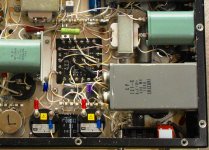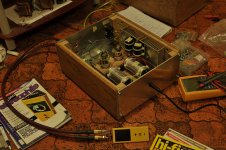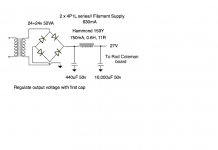Hi Hiro,
I very much agree with this philosophy and I usually follow most of those principles also in PP amplifiers.
The only thing that I usually don't do is bypass electrolytics. In reality I make a limited use of electrolytics only where high capacitance is required.
I am not aware of the "high order harmonics" absorbing property by using oil or MP caps in parallel to elecrolytics. What does it mean? Are you referring to PSU harmonics?
Yes, I was referring to the PSU harmonics.
On the other hand, I did attempt providing a combo of a) 2,200mF electrolytic cap and 8mF Oil cap for absorbing possible envelop of the signal.
As a result, it was found that there are improvements at transparency, clarity and excellent sound stage.
Yes, I was referring to the PSU harmonics.
On the other hand, I did attempt providing a combo of a) 2,200mF electrolytic cap and 8mF Oil cap for absorbing possible envelop of the signal.
As a result, it was found that there are improvements at transparency, clarity and excellent sound stage.
Hi Hiro,
I will experiment this bypass as well. I have big electrolytics of very good quality (330uF and 680 uF both rated 450V). I need to find some good oil caps though. What kind of oil capacitor do you suggest?
Hi Hiro,
I will experiment this bypass as well. I have big electrolytics of very good quality (330uF and 680 uF both rated 450V). I need to find some good oil caps though. What kind of oil capacitor do you suggest?
Hi
I use a very old Shizuki cap(8mF 400V 1968),but good at leak resistance.
Attachments
Hi
I use a very old Shizuki cap(8mF 400V 1968),but good at leak resistance.
OK. Thanks.
Yes, of course.
2P29L driving 4P1L PSE
I tested the 2P29L over the weekend and found it surprisingly good. Similar mu to 4P1L in triode strapped and very linear as well. The filament bias requirements are easy on 120mA filament current. A great preamp stage or driver for the 4P1L PSE:

The 4P1L PSE amp without follower for ultimate design simplicity:

Personally, I'd rather add a MOSFET follower stage to drive the 4P1L output stage for best performance and a tad more power in A2 mode.
I tested the 2P29L over the weekend and found it surprisingly good. Similar mu to 4P1L in triode strapped and very linear as well. The filament bias requirements are easy on 120mA filament current. A great preamp stage or driver for the 4P1L PSE:

The 4P1L PSE amp without follower for ultimate design simplicity:

Personally, I'd rather add a MOSFET follower stage to drive the 4P1L output stage for best performance and a tad more power in A2 mode.
Beautiful graphics!
With 15 mA, it possibly have enough drive/low rp to apply directly from anode to the grids of an class A1 output, cap-coupled with anode choke or trafo-coupled (for people fearing MOSFETs).
Now is hope that the accumulators decide not to buy the entire 2P29L world stock available ...



With 15 mA, it possibly have enough drive/low rp to apply directly from anode to the grids of an class A1 output, cap-coupled with anode choke or trafo-coupled (for people fearing MOSFETs).
Now is hope that the accumulators decide not to buy the entire 2P29L world stock available ...
Some time ago I made a two chassis 4p1l parafeed SPUD headphone amplifer for use with my Grado headphones. It uses CCS'es for anode load and Magnequest EXO-45 and paper oil capacitors in the output. And with filament bias of course. With more than 1V rms input it gets plenty loud. I tried out the 5842 and the 6N6 tubes first, but soundwise they were left in the dust by the almighty 4p1l. The most noiseless amp I have ever built and with superb bass.
Attachments
I've done a little more building this week - hadn't touched my 4P1L > 4P1L SET for a long while. I wanted to try out some line stages with 26, 4P1L and Ale's 01A with gyrator. So to play around with different line stages I built a couple of output stage chassis - just the single 4P1L output stage with OPT. I can now hook up different line stages to drive it with. I only use 2 stages from my DAC. Speakers are Alpair 10s.
First the output stage:
- LL1660/80mA configured 5K input into 8 ohms. This has a smooth sound, very pleasant but going towards dulling the detail slightly.
- LL1682/50mA, which is probably around 8K into 8 ohms. This had more air and more transient detail - more thwack in tom-toms in the drum kit, sharper rim shots, more air in the vocals and highs. Slightly less deep bass, but what was there was more defined - more resonance in the double bass.
Out of the two above I'd go with the LL1682 because of the overall superior detail and air, though it's close. However, the best of all the Lundahls might be the LL1663, which is 5K into 8 ohms.
Next the line stages. I tried both 4P1L with plate choke and FT-3 cap, and 26 with LL1660/5mA. This was close. Very hard to choose. I'd have to do more listening to express a preference. Slightly more gain with the 4P1L. Both very nice.
I've heard Ale's own 01A line stage in my system, and I thought that was the best I've yet heard in my system, so that's the next build.
Incidentally, I'm going to have some 4P1L amps left over here. Some PSETs with twin 4P1L output stage (makes it like a 2a3) with O-netics OPTs and 4P1L input stages. Anyone interested in those, send me a message.
First the output stage:
- LL1660/80mA configured 5K input into 8 ohms. This has a smooth sound, very pleasant but going towards dulling the detail slightly.
- LL1682/50mA, which is probably around 8K into 8 ohms. This had more air and more transient detail - more thwack in tom-toms in the drum kit, sharper rim shots, more air in the vocals and highs. Slightly less deep bass, but what was there was more defined - more resonance in the double bass.
Out of the two above I'd go with the LL1682 because of the overall superior detail and air, though it's close. However, the best of all the Lundahls might be the LL1663, which is 5K into 8 ohms.
Next the line stages. I tried both 4P1L with plate choke and FT-3 cap, and 26 with LL1660/5mA. This was close. Very hard to choose. I'd have to do more listening to express a preference. Slightly more gain with the 4P1L. Both very nice.
I've heard Ale's own 01A line stage in my system, and I thought that was the best I've yet heard in my system, so that's the next build.
Incidentally, I'm going to have some 4P1L amps left over here. Some PSETs with twin 4P1L output stage (makes it like a 2a3) with O-netics OPTs and 4P1L input stages. Anyone interested in those, send me a message.
Update:
LL1620/80mA and LL1682/50mA are still there but on the shelf. Listened to LL1664/70mA at the end of 2016 and liked that the best.
Then along came an amorphous core OPT. Don't know the maker, but it's well made. At first I found it harsh after the LL1664/70mA which was very nice and smooth and had a sweet treble. But the more I listened the more addicted I became, and it's staying in my system. I may have had some kind of oscillation at one point affecting the sound, but seems OK now.
Still using 2x4P1L in parallel as output tubes, but may try 3x 4P1L next, which would give a nice easy 100mA. I gave up on a single 4P1L with my Alpair 10 speakers.
For preamp I now use the 01A Gen 2 and very happy with it. The gyrator is better than the various Lundahl transformers I have, like LL1660 or LL1635. It just about drives the 4P1L output stage. Ale and I tried inserting a mosfet buffer, but it dulled the sound a little, so better without.
So that's my working combination of 2 stages right now. As I said before, I'm going to have a few amp and preamp stages left over from experiments so let me know if that is of interest.
LL1620/80mA and LL1682/50mA are still there but on the shelf. Listened to LL1664/70mA at the end of 2016 and liked that the best.
Then along came an amorphous core OPT. Don't know the maker, but it's well made. At first I found it harsh after the LL1664/70mA which was very nice and smooth and had a sweet treble. But the more I listened the more addicted I became, and it's staying in my system. I may have had some kind of oscillation at one point affecting the sound, but seems OK now.
Still using 2x4P1L in parallel as output tubes, but may try 3x 4P1L next, which would give a nice easy 100mA. I gave up on a single 4P1L with my Alpair 10 speakers.
For preamp I now use the 01A Gen 2 and very happy with it. The gyrator is better than the various Lundahl transformers I have, like LL1660 or LL1635. It just about drives the 4P1L output stage. Ale and I tried inserting a mosfet buffer, but it dulled the sound a little, so better without.
So that's my working combination of 2 stages right now. As I said before, I'm going to have a few amp and preamp stages left over from experiments so let me know if that is of interest.
Now is hope that the accumulators decide not to buy the entire 2P29L world stock available ...
I bought some for myself before revealing the secret. ;-)
Hi!
I am listening now to stereo amp with... 2.5W per channel!
Oh I just saw this. Do you have full schematic? I would like to drop out 4P1L PP and do your project instead.
For power supply, can you advise more easy schematic?
I have no time for full support, sorry... May be later I will publish something complete, not just main ideas.
But you can find ready to use filament PCBs. The tube become quite popular since I opened this topic, so people designed a lot around it!
The main idea is, to use it triode strapped, paralleled, 5K per tube load on 250V anode, in class A2, if you want 2.5W per tube instead of 1.8W in A1
In such case the amp does not need any feedback to sing clean, so is easy to implement by an amateur designer.
But you can find ready to use filament PCBs. The tube become quite popular since I opened this topic, so people designed a lot around it!
The main idea is, to use it triode strapped, paralleled, 5K per tube load on 250V anode, in class A2, if you want 2.5W per tube instead of 1.8W in A1
In such case the amp does not need any feedback to sing clean, so is easy to implement by an amateur designer.
Here's some hopefully useful information on a filament supply for 2 x 4P1L PSE, wired each in series then in parallel for 630mA at 4v. I used basic components, nothing exotic.
Transformer is a 50VA 0-24v 0-24v, twin secondaries, so 1.04A per secondary. This covers the 2 supplies. Choke is a Hammond 159Y rated 750mA. Main cap is 10,000uF at 50v. I regulated the output voltage with the first small cap. 220uF gave me around 26v, 440uF 27v and I could go on up for more output voltage. Using the first cap to regulate the voltage gives a bit of a quasi-choke input so better than a dropper resistor on the output.
I'm shooting for 17v to 18v bias for 30mA to 35mA per 4P1L, depending on anode-cathode voltage. Here I'm looking for 240v to 250v. I'm after an anode dissipation of 8W to 9W (9W max for 4P1L). It's on the bench right now so haven't made it all up and listened to it yet. I hope there's enough headroom and the transformer and chokes don't get hot. I could size it all up
Transformer is a 50VA 0-24v 0-24v, twin secondaries, so 1.04A per secondary. This covers the 2 supplies. Choke is a Hammond 159Y rated 750mA. Main cap is 10,000uF at 50v. I regulated the output voltage with the first small cap. 220uF gave me around 26v, 440uF 27v and I could go on up for more output voltage. Using the first cap to regulate the voltage gives a bit of a quasi-choke input so better than a dropper resistor on the output.
I'm shooting for 17v to 18v bias for 30mA to 35mA per 4P1L, depending on anode-cathode voltage. Here I'm looking for 240v to 250v. I'm after an anode dissipation of 8W to 9W (9W max for 4P1L). It's on the bench right now so haven't made it all up and listened to it yet. I hope there's enough headroom and the transformer and chokes don't get hot. I could size it all up
Attachments
Further bench testing of the above filament supply shows the maximum it will produce whatever the size of the first cap is around 26v. I had hoped for a bit more flexibility, like up to 30v. The Hammond 159Y is 11 ohms and this drops 7v at 630mA. Too much for me. Alternatives are the Hammond 159ZA, 300mH at 1A which drops 3.8v and the 159ZC 60mA at 2A which drops 0.5v. Both of those would give some more volts if needed. The other way of doing it is to use a 0-30 0-30v transformer but that's not a standard voltage.
- Home
- Amplifiers
- Tubes / Valves
- One more 4P1L SE


